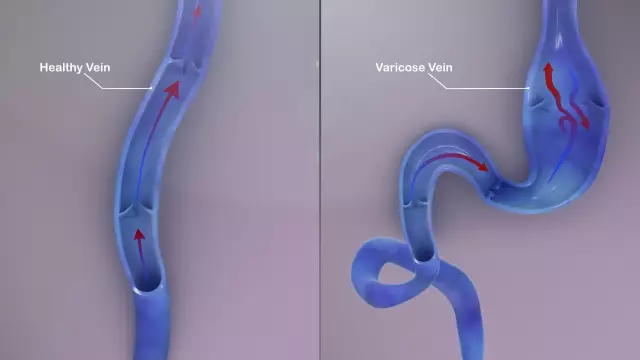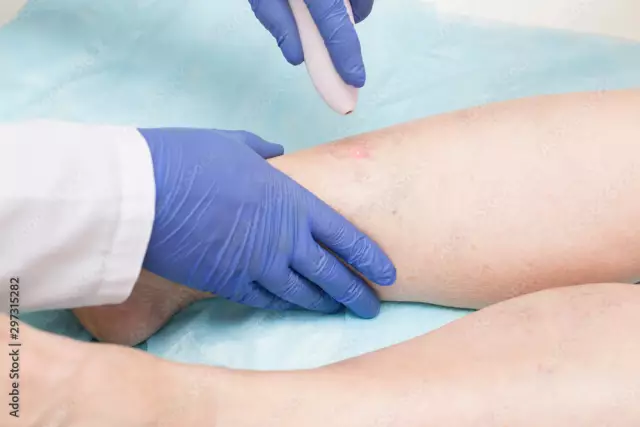- Author Rachel Wainwright [email protected].
- Public 2023-12-15 07:39.
- Last modified 2025-11-02 20:14.
Varicose veins
The content of the article:
- Causes and risk factors
- Forms of the disease
- Disease stages
- Symptoms
- Diagnostics
- Treatment
- Possible complications and consequences
- Forecast
- Prevention
Varicose veins of the lower extremities is a chronic disease of the veins, which is characterized by thinning of their walls, expansion of the lumen, and the formation of aneurysm-like nodes. Most often, varicose veins affect the lower extremities; it is one of the most common pathologies - about 40% of women and 20% of men suffer from it.

External manifestations of varicose veins of the lower extremities
Causes and risk factors
Blood flows upward through the veins of the lower extremities, that is, it has to overcome the force of universal gravity. This current is provided by the pressure of the tendons located near the veins and residual arterial pressure. The movement of blood through the veins of the lower extremities is also facilitated by the "muscle pump": during movement, the muscles of the legs contract and squeeze the veins, thereby forcing the blood in them upward, since the venous valves prevent the return flow.
Weakness of the muscular layer of the venous walls and the insufficiency of the valve apparatus cause the blood to flow in the opposite direction, that is, downward, under the influence of the action of the “muscle pump”. This leads to an increase in pressure on the walls of blood vessels, further progression of valve failure, expansion of the lumen of the veins and the formation of nodes. The muscle fibers of the venous walls atrophy, the work of nerve receptors that regulate venous tone is disrupted, which, in turn, further enhances the manifestations of venous insufficiency.

Pregnancy increases the risk of developing varicose veins of the lower extremities
Risk factors for the development of varicose veins of the lower extremities:
- hereditary predisposition;
- pregnancy;
- obesity;
- daily prolonged sitting or standing;
- activities associated with lifting weights;
- systematic wearing of tight clothes, corsets;
- unhealthy diet with insufficient dietary fiber and vitamins;
- hormonal disorders.
Forms of the disease
Based on the characteristics of clinical manifestations, the following forms of varicose veins of the lower extremities are distinguished:
- segmental lesion of the intracutaneous and saphenous veins with the absence of reverse blood flow in them;
- segmental lesion of the veins of the lower extremities, accompanied by pathological blood flow;
- widespread vascular lesion with reverse blood flow through the superficial veins;
- widespread vascular lesion, accompanied by pathological discharge of blood through the deep vein system.
Disease stages
In 2000, Russian phlebologists adopted a classification of varicose veins of the lower extremities, taking into account the form of the disease, the degree of venous insufficiency, the presence or absence of complications. In accordance with it, there are three stages of varicose veins of the lower extremities:
- Compensation stage. Patients do not make any complaints. On examination, superficial dilated veins are found on one or both legs.
- Subcompensation stage. Patients complain of nocturnal cramps, disorders of skin sensitivity (paresthesia) in the legs, and a feeling of fullness. In the evening, swelling of the legs, ankles and feet is often observed, which disappears after a night's sleep. On examination of the legs, dilated varicose veins are clearly visible.
- Decompensation stage. Eczema, dermatitis are added to the signs described above. The skin is hyperpigmented, dry, shiny, tightly adhered to the subcutaneous tissue.

Stages of varicose veins of the lower extremities
Symptoms
The clinical picture of varicose veins of the lower extremities is determined by the stage of the disease. So, with the compensated stage, the only symptom of venous insufficiency is the appearance of spider veins (telangiectasias) on the legs.
The transition of the disease to the subcompensated stage is accompanied by the appearance of pain in the legs, swelling of the feet and ankles, cramps in the calf muscles. After resting in a horizontal position, these symptoms disappear.

The first symptoms of varicose veins of the lower extremities
The most vivid clinical picture of varicose veins of the lower extremities is manifested in the decompensated stage of the disease. The pain in the legs becomes constant. Patients complain of itching of the skin, which intensifies in the evening and at night. Over time, dermatitis, eczema, and difficult-to-heal trophic ulcers develop. At this stage, common symptoms are common: dizziness, low blood pressure. They are associated with the deposition of significant volumes of blood in the expanded venous network of the legs.
Diagnostics
Diagnosis of varicose veins of the lower extremities is not difficult. It is carried out on the basis of the characteristic clinical signs of the disease and the data of an objective examination.

Ultrasound examination of the veins of the lower extremities
To assess the severity of hemodynamic disorders, instrumental diagnostic methods are used:
- Doppler ultrasonography of the veins of the lower extremities;
- duplex angioscanning;
- rheovasography of the veins of the lower extremities.
Treatment
In the treatment of varicose veins of the lower extremities, according to indications, the following methods or their combination are used:
- conservative therapy;
- sclerotherapy;
- surgical intervention.
Conservative therapy of varicose veins of the lower extremities can be recommended for patients in the early stages of the disease, its goal is to prevent the progression of chronic venous insufficiency. It is also used for subcompensated and decompensated stages of the disease during the preparation of the patient for surgery or in cases where the use of other methods is contraindicated. Conservative therapy of varicose veins is based on the use of phlebotonics, wearing compression hosiery. In addition, patients are advised to regularly engage in physiotherapy exercises, to avoid prolonged static loads.

Compression stockings are recommended in the early stages of varicose veins of the lower extremities
In case of varicose veins of the lower extremities, not complicated by significant hemodynamic disturbances, compression sclerotherapy can be used. The essence of the method consists in administering a drug to the affected vein, causing its spasm. After that, a compression stocking is put on the leg or the leg is bandaged with an elastic bandage, which allows maintaining the walls of the vein in a collapsed state. A few days later, the process of gluing the walls of the veins begins. Compression underwear should be worn after sclerotherapy for at least one and a half months, until the formation of sufficiently dense adhesions between the walls of the vein.
In advanced stages of varicose veins of the lower extremities, the most effective method is surgical. The methods of operating techniques are selected based on the stage of the disease, its form, characteristics of hemodynamic disorders:
- laser coagulation;
- radio frequency coagulation;
- miniflebectomy;
- phlebectomy.

Laser coagulation of varicose veins of the lower extremities
Possible complications and consequences
Complications of varicose veins develop mainly in the stage of decompensation. These include:
- phlebitis (inflammation of the dilated vein);
- thrombophlebitis (inflammation of a vein with the formation of blood clots in its lumen);
- bleeding from varicose veins;
- trophic ulcers;
- pulmonary embolism (PE).
Forecast
The prognosis of varicose veins of the lower extremities with timely treatment is favorable.
Prevention
In order to prevent varicose veins of the lower extremities, it is necessary to avoid prolonged static loads. If the work requires a long stay in a standing or sitting position, you should periodically take breaks for a little gymnastics or at least walking. After a working day, it is recommended to lie down, giving your legs a horizontal or elevated position.
In the prevention of varicose veins, a significant role is assigned to active activities: sports (swimming, cycling, fitness), dancing, walking, etc.
YouTube video related to the article:

Elena Minkina Doctor anesthesiologist-resuscitator About the author
Education: graduated from the Tashkent State Medical Institute, specializing in general medicine in 1991. Repeatedly passed refresher courses.
Work experience: anesthesiologist-resuscitator of the city maternity complex, resuscitator of the hemodialysis department.
The information is generalized and provided for informational purposes only. At the first sign of illness, see your doctor. Self-medication is hazardous to health!






